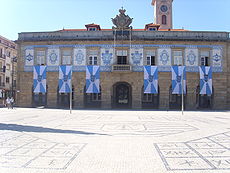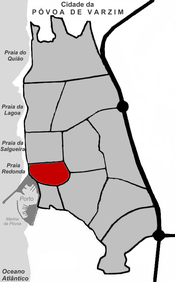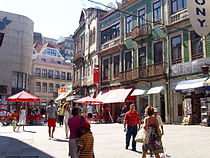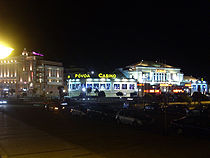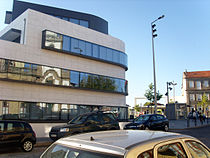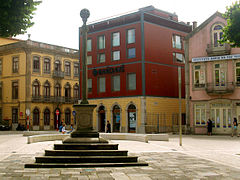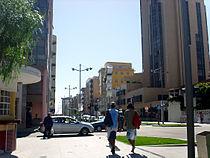- Póvoa de Varzim City Center
-
Póvoa de Varzim City Center or Downtown Póvoa de Varzim (Portuguese, Centro) is the heart of Póvoa de Varzim in Portugal, and is the location for most of the city's municipal services, tourist attractions and businesses. It is the center, not only for the city or the municipality, but also neighboring municipalities. The greater downtown area also called "Centro" can also include most districts part of Póvoa de Varzim Civil Parish.
Downtown, as defined by the City Hall, is arranged around Praça do Almada, the civic center, and extends in all directions for a number of blocks, including Junqueira shopping street, Passeio Alegre waterfront square, Mouzinho de Albuquerque business avenue, and Praça Marquês de Pombal (market square). It does not include the medieval and Discovery Age civic center of the city which is located in Bairro da Matriz district.
Despite proven to be occupied at least since the Roman period, Downtown developed its current layout in the 18th century, by royal order of Queen Mary I of Portugal due to the importance that Póvoa de Varzim got as the main seaport in Northern Portugal.
Urban morphology
Downtown is limited to the North by Bairro Norte, to the south by Bairro Sul, to the east by Barreiros/Moninhas and Matriz/Mariadeira and to the west it borders the by Redonda Beach and Póvoa Cove.
Downtown Póvoa de Varzim is, to a large extent, made up of pedestrian areas, with the difficult car access in much of its extension. Praça do Almada, the civic center, is landscaped in an egg-shape, cut in half by the National Highway 13, and is tipped by buildings with long-established national taste. The building of the City Hall (1791) dominates the square. In the way of the square, the Manueline pillory of Póvoa de Varzim (1514) is a national monument and represents the municipal emancipation of Póvoa de Varzim. Next to the pillory, the square's romantic gazebo (1904) follows the liking of the old Povoan bourgeoisie for its spare time.[1]
From the surroundings of Praça do Almada, three parallel streets lead to the waterfront: Tenente Valadim, that ends between the Casino and Grande Hotel, Junqueira and Santos Minho, this one related with the arts, where it persists the old building Salão Teatro ( Theater Saloon) in its beginning, headed by Garrett Theater from the 19th century, with small artist's studios in the way.
Despite being pedestrian, Junqueira is the most famous and elder of those three streets. Junqueira street, which binds Praça do Almada to the waterfront, appears in the written records for the first time in 1694, even though artifacts from the Roman era have been surfaced in diverse street rearrangements. In 1839, the Town Hall expressed concerns over urbanization issues due to popularity of this street, one of the busiest in Póvoa de Varzim, it became in that century a full-blown shopping street, identity maintained to these days and proved by the survival of centenary stores.
Undersized but charismatic squares through the way of Junqueira, between Praça do Almada and Passeio Alegre (waterfront) can be found: Praça da República and Largo David Alves.
History
Main article: History of Póvoa de VarzimAlbeit inhabited since the Roman times, with the seaport being regularly used since the 11th century, and the ship-making industry developed considerably in the 17th century, it was in the 18th century, with the fishing industry getting national importance, that defined the city center as it is today, with the Royal Provision by Queen Mary I on February 21, 1791. The queen ordered Corregedor Almada to reorganize the town's layout given Póvoa's prosperity and importance in the fishing sector.
The new civic center (Praça Nova - New Square) was built, where the new town hall was raised. The square was later renamed Praça do Almada in honor of Corregedor Almada efforts. The new square substituted the old civic center around Praça Velha, the Old Square, where the old town hall is located in Uptown Póvoa de Varzim.
Prior to that, Junqueira street and surroundings were already a bustling fishing quarter. As the 19th century moved in, and beach therapy became popular with the elites, Junqueira became a shopping street.
In late 19th century and under the visions of David Alves, when Póvoa de Varzim was already a prosperous beach resort, sections of the urbanized area, which didn't grew in an orderly namer, were demolished to give way for Mousinho de Albuquerque Avenue, linking Passeio Alegre Square (Largo do Passeio Alegre) to uptown's Dores Square (Largo das Dores), where mansions for the wealthy beach goers started being built. During late 20th century, some of the mansions and Orfeão Poveiro music hall ruins were destroyed to give rise to multifamily homes. Despite its losses, Mousinho Avenue got a new character, it became a central business avenue and a rehabilitation program was done in the 21st century.
Around Rego Square, later David Alves square, appeared some of the most charismatic entertainment venues of Póvoa in the 19th century, the Hotel Luso-Brazileiro, the Chinês Saloon, Garrett Theater, and other entertainment venues. Centering the plaza, the Chinês Saloon appeared in 1882 and became popular all over the country and the most famous casino of Póvoa along side with Café David. The elites could listen to music, see shows with Spanish dancers, meet in tertulia and play roulette.
Old bourgeois area par excellence, with the increasing business importance of Junqueira and Praça do Almada, whose spaces had been taken for tertiary activities such as shops and offices, in such a way that, today, only few people live in the most central areas of the city.[2]
References
- ^ Coreto da Praça do Almada - IGESPAR
- ^ As Procissões na Póvoa de Varzim (1900–1950). Volume 1 - Deolinda Carneiro, Faculdade de Letras da Universidade do Porto. 2006
Categories:- Central business districts
Wikimedia Foundation. 2010.

